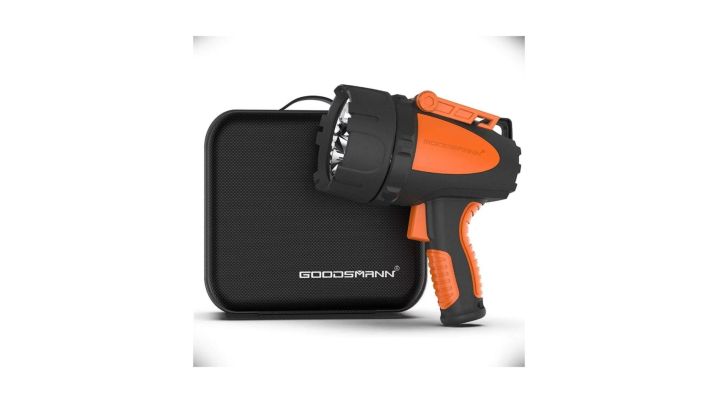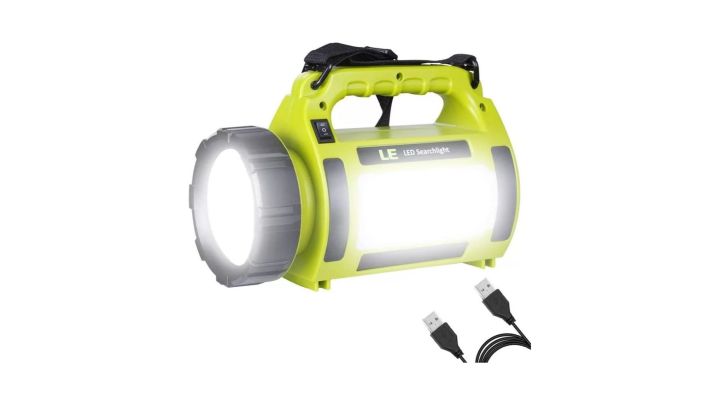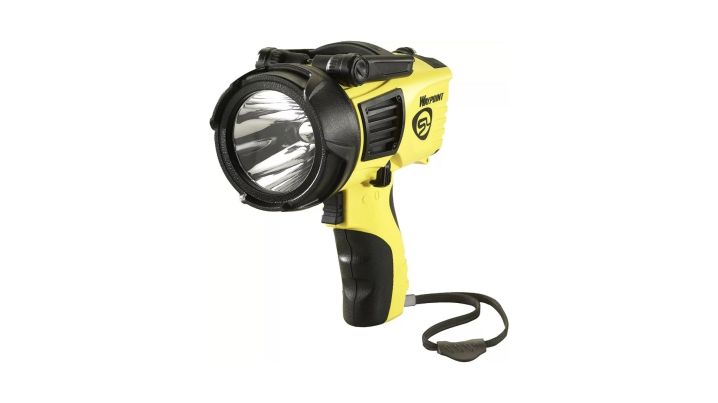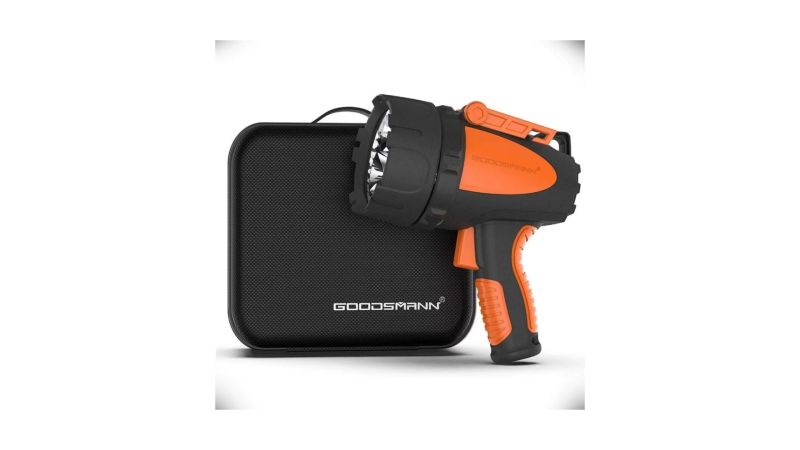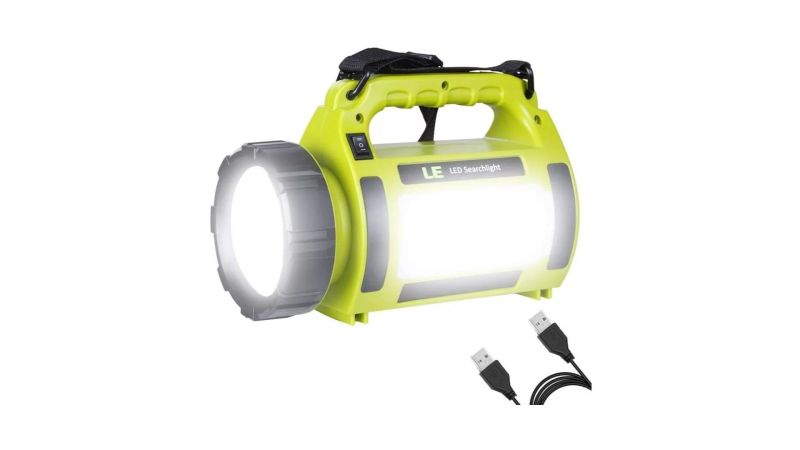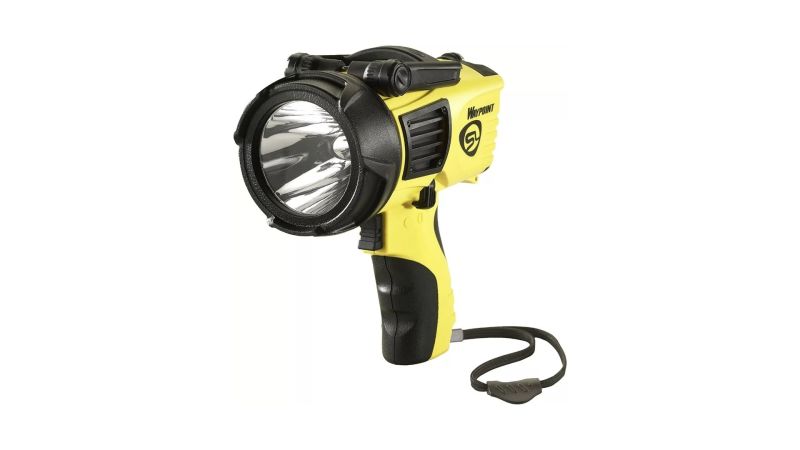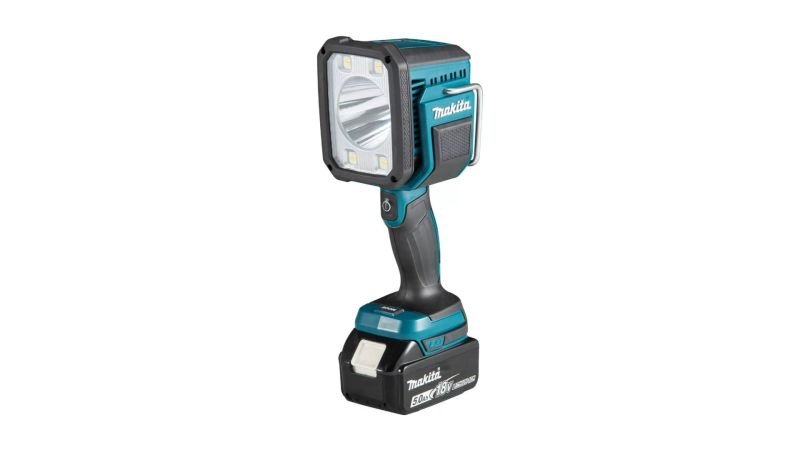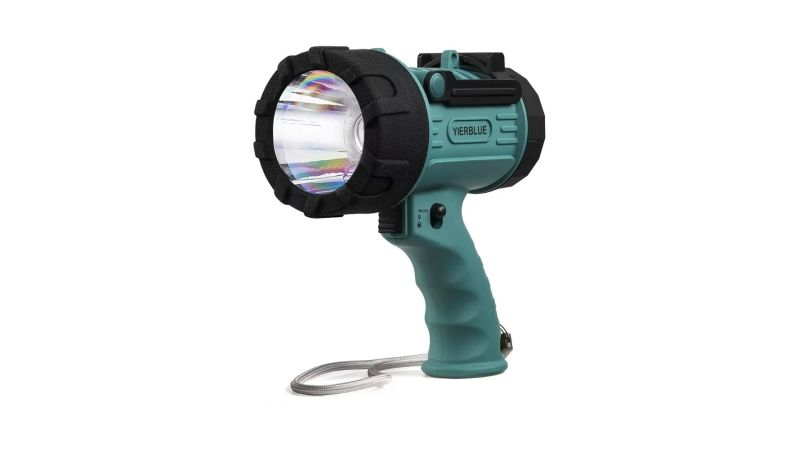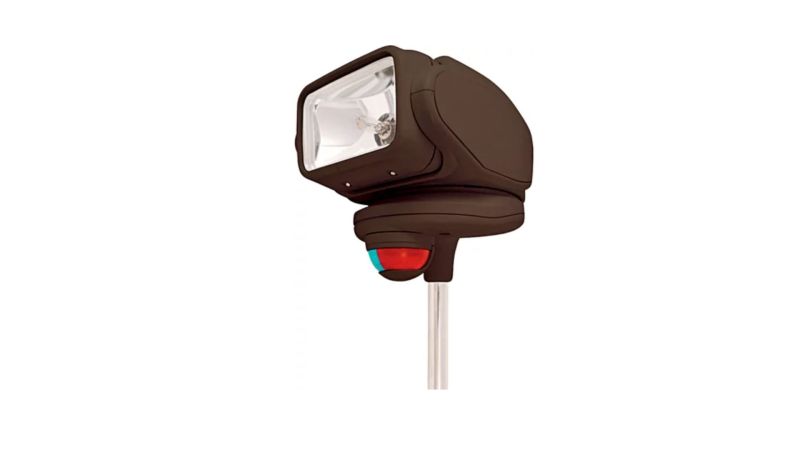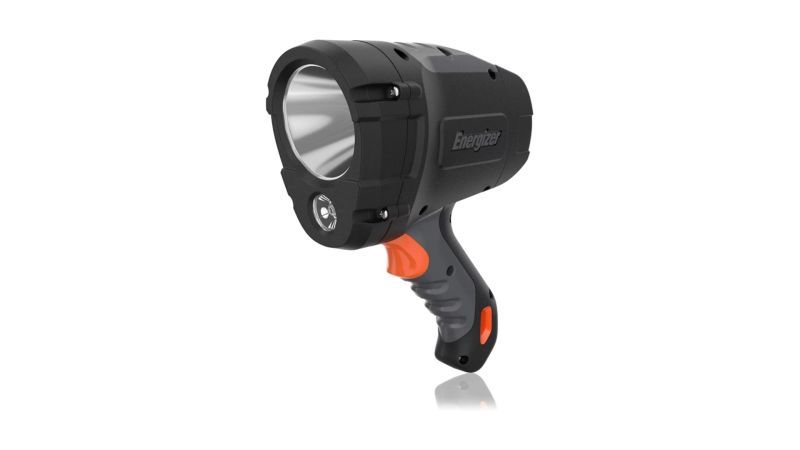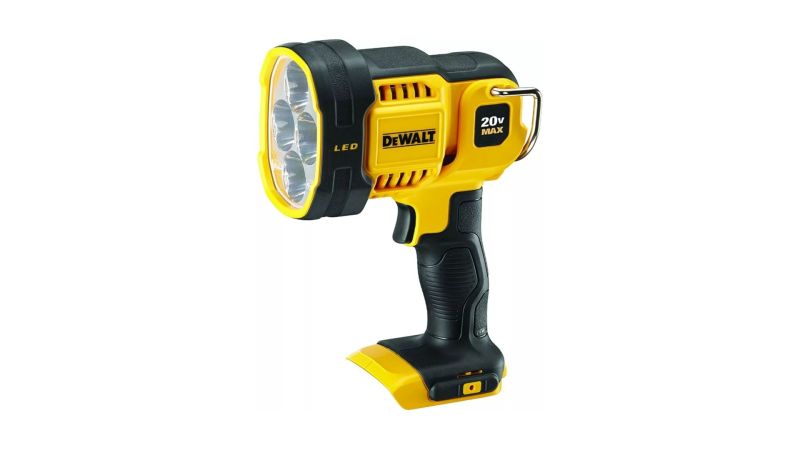We may earn revenue from the products available on this page and participate in affiliate programs.
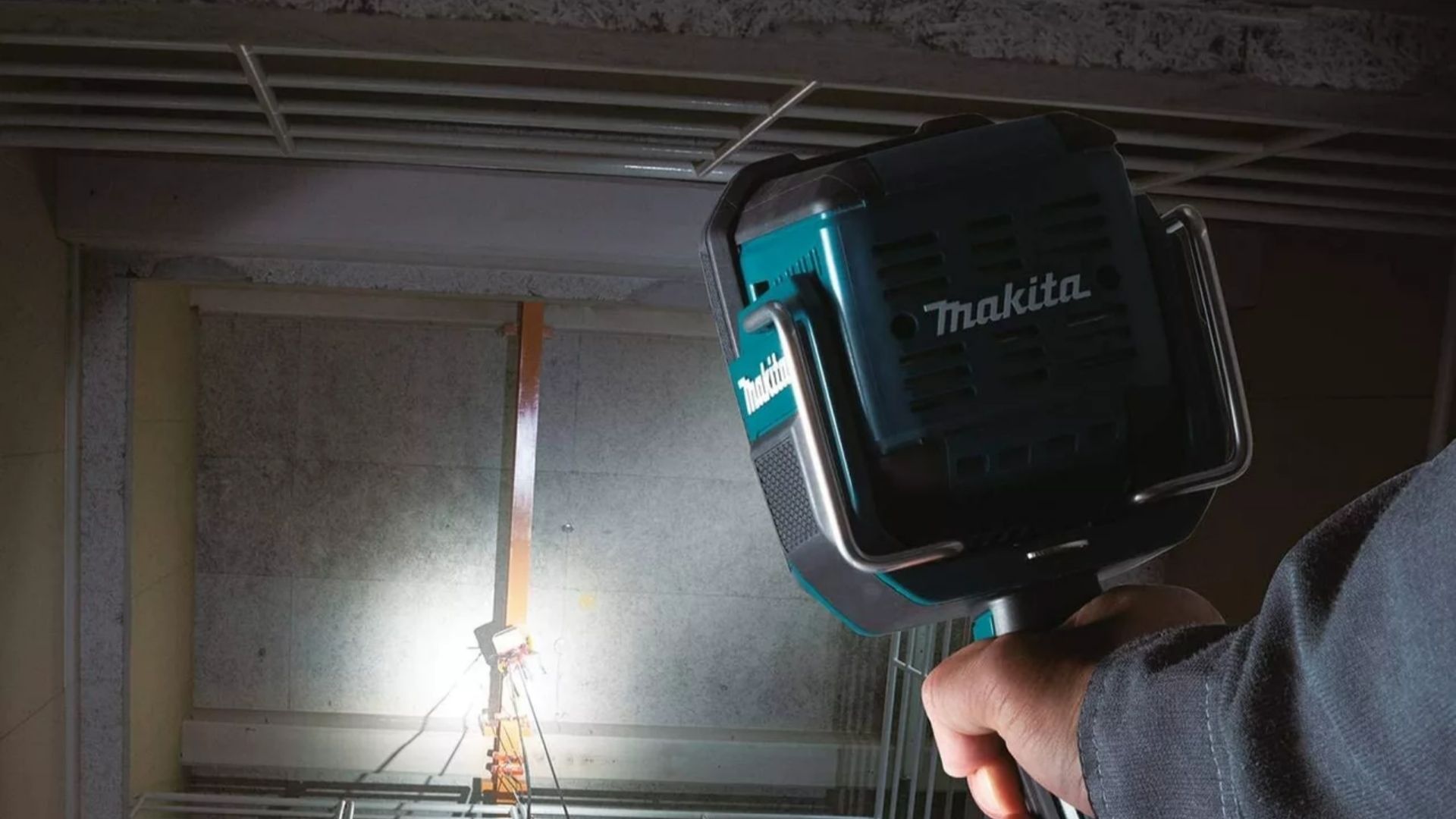
Spotlights are easily one of the most underrated tools for nighttime work. Prior to the LED revolution, spotlights were a commonly found tool for night shifts everywhere. At the time, flashlights weren’t very strong, but now that you can easily find a 1,000-lumen flashlight, spotlights have started to fade from popularity. But the very design and functionality of spotlights make them more ideal than flashlights for many jobs. These handheld powerhouses are specifically made to illuminate objects hundreds of yards away.
If you work or play after the sun goes down, then you need to consider adding one of the best spotlights to your gear locker.
- Best Overall: Goodsmann Rechargeable Hunting Spotlight
- Best Value: LE Rechargeable Camping Spotlight
- Editor’s Choice: Streamlight Waypoint 1000 Lumen
- Best Rechargeable: Makita 18V Spotlight
- Best for Long Distance: Yierblue YBN-2000G Spotlight
- Best Boat-Mounted: GoLight GoBee Spotlight
- Best for Backyard: Energizer LED Spotlight
- Best for Job Sites: DeWalt 20V LED Work Light
Methodology
In a perfect world, I would be able to get hands-on with the best spotlights available to put them through rigorous testing and provide you with scientifically measured data to decide on. That just wasn’t feasible for this best spotlights review, so instead, I had to rely on my personal experiences in the military and construction worlds. Having used several different types of spotlights gave me a base knowledge to conduct in-depth research to evaluate each product objectively.
As a writer for Task & Purpose, I’ve developed this skill through articles like the best gun oils, best camping chairs, and best running socks where there are an overwhelming amount of choices. Task & Purpose has covered the illuminating choices for the best 1000 lumen flashlights, headlamps, rechargeable flashlights, and EDC flashlights.
For this article, I relied heavily on personal experience with brands like DeWalt, Makita, and Streamlight for baseline information. I also compared other buying guides to identify spotlight options that would fit the different categories selected. I avoided spotlights with unrealistic claims, questionable or inconsistent information, and products and brands with known histories of quality control issues. The below result is a selection of the best spotlights you can buy.
Best Overall
Goodsmann Rechargeable Hunting Spotlight
Best Value
LE Rechargeable Camping Spotlight
Editor’s Choice
Streamlight Waypoint 1000 Lumen
Best Rechargeable
Makita 18V Spotlight
Best for Long Distance
Yierblue YBN-2000G Spotlight
Best Boat-Mounted
GoLight GoBee Spotlight
Best for Backyard
Energizer LED Spotlight
Best for Job Sites
DeWalt 20V LED Work Light
Our verdict on the best spotlights
The number one choice for brightness and performance is easily the Goodsmann Rechargeable Hunting Spotlight. A quality runner-up is the Streamlight Waypoint, which offers 1,000 lumens. For distance, you can’t beat the Yierblue YBN-2000G Spotlight with a max range of 1,600 feet. There are other great options like the Makita 18V Spotlight and DeWalt 20V Spotlight that integrate with existing toolsets. If you’re looking for affordable and versatile options, you can select the LE Rechargeable Spotlight or the Energizer LED Spotlight. And anyone looking to mount a spotlight to their boat ought to consider the GoLight GoBee Stanchion Spotlight.
What to consider when buying a spotlight
How do you know which spotlight is right for you and the job? By understanding the basic types and features you’ll find on the best spotlights on the market, you can make an informed decision.
Types of spotlights
Halogen
For the better part of the past century, halogen bulbs have been the predominant choice for spotlights. This is because the recycling properties of halogen made the bulbs perform better and last longer at higher lumens. Each halogen bulb has a lifespan though, and it’s important to keep spare bulbs at the ready.
LED
While LEDs have been around for longer than most believe, they didn’t really become affordable and take off until the turn of the millennium. Light-emitting diodes have changed the lighting industry and tech industry at large by producing more light and using less energy. These types of spotlights often run longer and last longer than traditional variations ever could. The downside is that the LEDs aren’t as easy to replace if they burn out.
Key features of spotlights
Power source
There are a few different power sources available for you to consider. For handheld spotlights, you have the option between replaceable batteries or rechargeable spotlights. Rechargeables have an internal battery that can be charged through wall or car charging cables. Spotlights can be designed to use almost any size of a replaceable battery, although most use AA or similar-sized batteries. If you’re looking to mount a spotlight on vehicles or buildings, you’re going to want to hardwire those.
Grip
One of the things to consider when purchasing a spotlight is the type and style of grip. Traditional handles are horizontal and can make them challenging or uncomfortable after extended use. Pistol-style grips have a vertical grip section jutting out of the bottom of the spotlight and offer a more comfortable use for extended periods of time. Mounted spotlights can have a wireless controller like the GoLight GoBee.
Stand
Plenty of jobs require the use of both hands for tools and equipment. Handheld spotlights can make that challenging or even impossible at times. Most of the products on this spotlight review feature a built-in stand or hanging device for this very reason.
Wrist strap
Many handheld spotlights have a hole in the grip for attaching wrist straps, most even include one with your purchase. Wrist straps are not required, but they can be handy if you’re working at height or over water. These simple straps can help prevent dropping your spotlight and save you plenty of dough.
Spotlight pricing
When you’re looking at prices, it can easily get overwhelming. Budget-priced spotlights range under $50 and can perform well, but are not always as strong or durable as higher-priced lights. Moderately-priced spotlights range between $50 and $100 and represent the middle of the pack. Premium-priced spotlights are found above $100 with features, performance, and brightness levels that can’t be beaten. Money spent in the moderate and premium range is worthwhile since those spotlights are most likely to last years.
Tips and tricks
As with something you do for decades upon decades, you pick up a few tips and tricks along the way in terms of selecting the right product, and/or using it. That’s the case with us and spotlights. To help you bridge the information gap, here’s a selection of what we’ve learned along the way.
- Always keep spare bulbs for halogen spotlights
- Likewise, with battery-powered spotlights, pack spares
- Check your state’s laws before using a spotlight for hunting or scouting
- Use your wrist strap when working at height or around water
- Never aim your spotlight directly at people or vehicles, including airplanes
FAQs about spotlights
You’ve got questions, Task & Purpose has answers.
Q: How many lumens is a good spotlight?
A: This is really subjective to the distance you’re attempting to spot at. I’d strongly recommend no less than 600 lumens for spotlights, as this will give you a decent range for most applications, but the farther you’re shining the higher power you’ll need.
Q: Can I use my spotlight as a battery bank?
A: Several of the spotlights on this list can double as a battery bank, however, I strongly encourage getting a separate and dedicated battery bank to prevent draining your spotlight unnecessarily.
Q: What’s the difference between a floodlight and a spotlight?
A: A floodlight is designed to illuminate large areas like fields or lakes. Spotlights are used to light up a specific area and have a more focused beam.
Q: What’s the difference between lumens and candela power?
A: Simply put, the difference is candela is the source power and lumens is the total available light. You can view an in-depth breakdown here.
